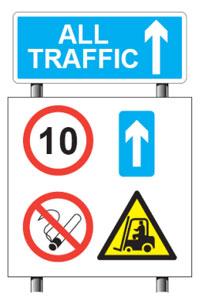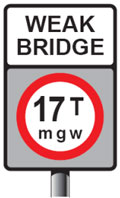Signs are necessary to tell drivers and pedestrians about the routes they should use, and also to instruct people how to behave safely (for example, whether they must use protective equipment, and how).

Figure 22 These clear signs help arriving drivers know what to expect
You should use route markings to show traffic lanes, route edges, priority at junctions, stop lines, no-parking areas, pedestrian crossings and so on, and to instruct drivers (for example, 'SLOW').
By law, road signs used to warn or give information to traffic in private workplaces must be the same as those used on public roads, wherever a suitable sign exists. Road signs are set out in The Highway Code.13 Drivers and pedestrians should be able to expect that the layout, signs, road furniture and markings on site will be similar to those on public roads.

Note: figures shown here are for illustration only
Figure 23 These signs can be used to show no vehicles over the height or width shown can continue
You should use warning signs to show hazards along the way.

Note: sign shown here is for illustration only
Figure 23 A sign like this should be used to show that no vehicles over a certain maximum gross weight shown can continue, and why
You can use traffic lights to control the flow of traffic at busy junctions, at narrow places and at site entrances. You can also use speed sensors and flashing warning signs to help control the speed of traffic.
You should provide signposting so that drivers do not go the wrong way. This should help prevent vehicles from moving around areas where pedestrians or other drivers might not expect them.
You should place signs so that people have time to see and understand them, and take any action to reduce risks before they reach the hazard.
All signs should:
- be clear and easy to understand;
- stand out enough to be noticed; and
- be kept clean and well maintained so that they are visible at all times.
If signs have to be visible in darkness, they will need to be reflective and, ideally, illuminated. Sign lighting needs be kept clean and working.
You can find detailed information about reflective and lit road signs in BS 873-1: 1983 Road traffic signs and internally illuminated bollards.